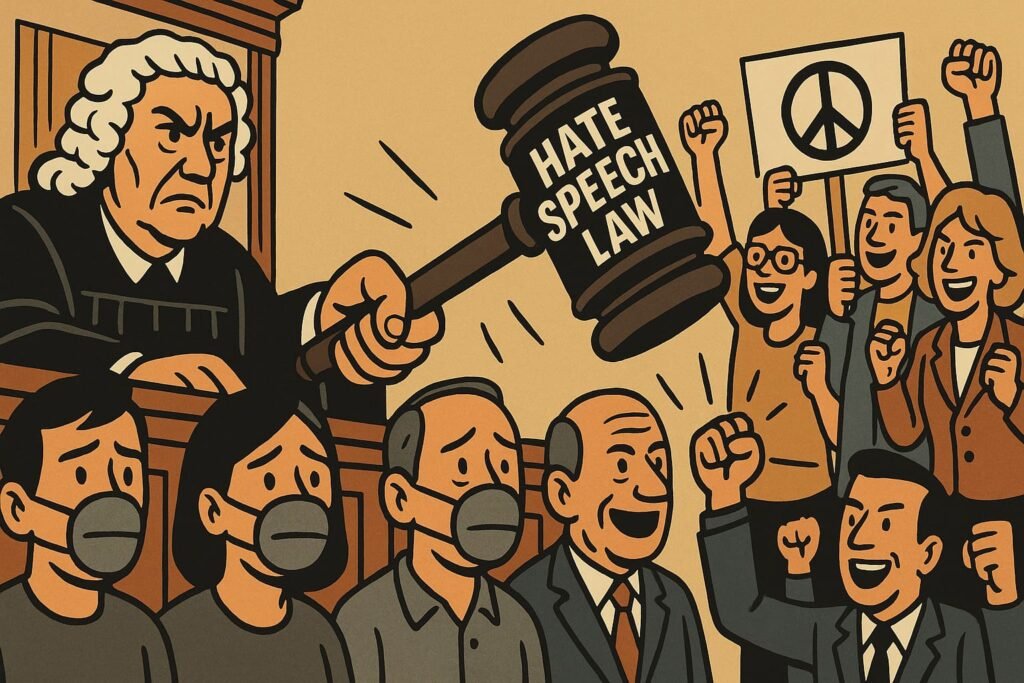Hate Speech – From Protection to Thought Control
When Words Become Weapons
“Hate speech” sounds noble. Who wouldn’t want to protect people from harm?
But scratch the surface, and hate speech laws aren’t about kindness — they’re about control. They turn free expression into a minefield, where saying the “wrong” thing can cost you your job, your reputation, or even your freedom.
What started as political correctness has morphed into thought policing with legal backup.
Table of contents
What Is Hate Speech?
There’s no universal definition. In general, hate speech is speech said to target groups based on race, religion, gender, sexuality, or identity.
But here’s the problem:
- In one country, criticism of religion = hate speech.
- In another, criticism of gender ideology = hate speech.
- In another, political dissent = hate speech.
The meaning moves to fit the agenda.
Buzzwords of Hate Speech
The vocabulary softens the censorship:
- “Words are violence” – Speech equated with physical harm.
- “Marginalised voices” – Some groups always shielded, others never.
- “Zero tolerance” – Any offence treated as criminal.
- “Safety” – Emotional comfort elevated above free expression.
Each phrase makes censorship sound compassionate.
How It Works in Practice
Hate speech laws rely on three tricks:
- Vague definitions → “Hate” is whatever the state or mob says it is.
- Fear factor → People censor themselves before speaking.
- Selective enforcement → Activists and elites get away with venom; ordinary citizens get fined, banned, or worse.
It’s not protection. It’s a speech filter designed to keep conversation one-sided.
Orwell Wasn’t Wrong
This isn’t far from Orwell’s 1984:
- Big Brother = state and corporations monitoring speech.
- Newspeak = today’s woke language policing.
- Thoughtcrime = questioning the narrative.
We’re not burning books — we’re rewriting dictionaries and prosecuting opinions. Same result.
Why Institutions Promote It
Because controlling language means controlling power.
- Governments use hate speech laws to muzzle dissent.
- NGOs push campaigns to expand what counts as hate.
- Universities justify speech codes and training programs.
- Corporations censor platforms to stay “brand safe.”
The vaguer the term, the wider the net.
The Consequences
- Fear – people stay silent rather than risk punishment.
- Shallow debate – controversial issues never get honestly discussed.
- Authoritarian drift – governments gain a tool to silence dissent.
- Cultural conformity – art, comedy, and public life become bland.
Instead of protecting democracy, hate speech laws hollow it out.
Why It Matters
Free speech isn’t about protecting polite views. It’s about allowing difficult ones. Once “hate” is defined by activists and politicians, disagreement itself becomes criminal.
That’s not justice. That’s thought control.
From Protection to Policing
Hate speech laws promised protection. What they delivered was policing of thought, enforced by bureaucrats, activists, and corporations.
It’s not about stopping hate. It’s about controlling who speaks.
Hate Speech vs Free Speech
| Hate Speech Laws | Free Speech |
|---|---|
| Offence = crime | Offence = debate |
| Definitions vague, ever-changing | Principles stable, universal |
| Protects ideologies | Protects individuals |
| Encourages self-censorship | Encourages open dialogue |
| Selectively enforced by elites | Equally applied to everyone |
| Produces fear & conformity | Produces innovation & progress |
FAQ
What are hate speech laws in plain terms?
Rules that criminalise certain speech on the grounds it’s offensive — often vague and open to abuse.
Why are hate speech laws controversial?
Because there’s no clear definition — and they’re selectively enforced by elites.
Where do hate speech laws show up?
In politics (laws), universities (speech codes), workplaces (HR policies), and online platforms (bans).
Who benefits from hate speech laws?
Governments, NGOs, universities, and corporations that gain power from policing speech.
How do hate speech laws link to DEI and identity politics?
They reinforce DEI’s speech policing, protect groups ranked by [Intersectionality Explained], and overlap with [Inclusion Explained] and [Microaggressions Explained].



